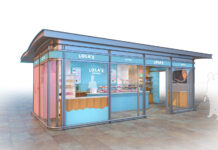Global e-commerce jumped to $26.7 trillion in the first year of the pandemic, a dramatic leap forward from a trend that had already hobbled many high street retailers. Unable to contend with the double whammy of changing consumer behaviour and a COVID-induced slump, dozens of brands fell into administration, from Arcadia and Debenhams to Monsoon and Cath Kidston, with the closure of hundreds of physical stores.
While some recovered, the prevailing narrative has been that bricks-and-mortar retail fell out of fashion. But with Amazon, IKEA, Sports Direct and Harrods opening new flagship stores – could there be another factor at play?

One key reason so many retailers imploded under COVID is that they were stuck with obsolete IT systems and outdated infrastructure that could not adapt to the emerging omnichannel wave. Shackled by a legacy mindset along with a culture that was resistant to change, many veteran brands found themselves technically stranded in a sea of fast-moving rivals.
However, for retailers still in business, it’s not too late to fight back. And in the battle for digital fluency, composable tech is a core ingredient.
A bespoke solution for uncertain times
As the name implies, ‘composable’ involves cherry-picking the right digital commerce solutions and configuring them to meet a company’s particular needs. Put simply, it is about decoupling a retailer’s business from slow-moving legacy IT stacks and replacing them with a modular, responsive open market ecosystem. Implemented at the right time, this allows retailers to reinvent their relationship with customers.
A lot of jargon is bandied about in this context, for example, Microservices, API, Cloud and Headless (collectively called MACH); and JavaScript, APIs and Markup (shortened to the snappier sounding JAMstack). What retailers need to focus on above all, however, is that composable IT enables them to provide a differentiated, responsive digital offering. This, in turn, can re-energise brands and help them establish a rejuvenated high street presence.
Large companies may be concerned about the write-down of their existing IT investment. But the beauty of composable architecture is that it can be built in parallel with the existing IT set-up – only cutting ties with the latter when the incoming system has proved its worth. In other words, regardless of size or budget, no retailer is shut out of the composable commerce revolution.
Here are five key benefits of composable IT:
- Improved efficiency: Companies with legacy IT systems get to a point where they need to upgrade to avoid obsolescence. But replacing a monolithic IT platform is costly, culturally disruptive, and a drain on resources. By contrast, composable architecture is relatively inexpensive because of its modular design. Built to be agile, it facilitates speed to market and helps businesses pivot in a strategic direction.Gartner forecasts that businesses embracing a composable approach will outperform their rivals by 80% in terms of how fast they can implement new features. Etailer fashion brand Shein is a classic example of a brand using flexible and modular IT to outperform rivals. It’s interesting to note Shein recently opened a London pop-up store with fellow industry disruptor Klarna.
- Ability to access best-in-class solutions: Ecommerce 1.0 saw companies rely heavily on a single IT vendor to meet all their needs. But that isn’t necessarily the best way to respond to the rapidly-evolving retail sector. Composable commerce is all about working lean, with products/solutions that are precisely right for the task; for example, implementing new website features. LoveCrafts is an online community and commerce platform for crafters based around three pillars: content, community and commerce. The brand’s decision to embrace composable early on has allowed these three pillars to grow independently and also to connect using metadata. Crafters can access supplies to buy a specific pattern, or search for community-shared patterns. LoveCraft’s composable approach has led to it becoming a top global destination for knitting and crochet supplies, meaning it was ideally placed at a time when interest in these hobbies peaked.
- Turbo-charged user experience: Composable IT allows retailers to offer customers a unique and/or differentiated experience. This might, for example, mean a seamless and intuitive omnichannel experience. Or it could be a highly personalised marketing campaign to stop shoppers from deserting. Either way, it dovetails neatly with the shift towards the experience economy. Fitness brands such as Basic Fit and GymShark are leading the way here. Gymshark, which passed $500m in revenues in 2020, is a poster child for the shift to composable tech, revolutionising its online search capabilities and personalisation by shifting towards a more modular and scalable IT architecture.
- Rapid response: Another attribute of composable commerce is that it allows retailers to respond rapidly to changes in their market. This can enable them to seize a competitive advantage by outflanking their closest competitors. Iconic sports brand Puma’s ambition was to be able to get its team’s ideas into production within days, with a prototype available within a week. However, its legacy tech and monolithic structure ruled out this level of speed. Switching its technology to a centralised cloud-based service and adopting a more composable approach to e-commerce has helped Puma close the gap, turning concepts into a reality at greater speed.
- The democratisation of tech: The IT solutions that drove the first wave of e-commerce were expensive to implement and overhaul. The advantage of composable architecture is that it can be built hand-in-hand with brand growth. An SME can start small and scale steadily, or stay small, depending on its needs.
The road to digital agility
Composable IT makes a perfect fit for the demands of post-COVID retail, a sector that is fast-moving and endlessly evolving. Its benefits extend way beyond tech, too. The composable approach facilitates companies that favour a test-and-learn culture, drawing on an open-source ecosystem.
Retailers that embrace the potential of composable architecture will find that their business culture also starts to realign around creativity, adaptability and problem-solving. Their entire outlook will become less stagnated and more iterative, vital for a volatile climate in which unpredictable online shopping habits will continue to reign supreme.
Now is not the time for retailers to rest on their laurels. Instead, those looking to thrive post-COVID can begin with a future-proof omnichannel experience: one that lays the groundwork for a seamless and user-centric platform to cut smoothly through the crosswinds ahead.




















